Introduction from us…
We did this class on Friday and Saturday evenings last year. When bookings became available for this year, we decided to repeat the sessions because we had such a good time last year, we learned a lot, and repetition makes knowledge stick.
Before the session began on Friday evening, we met Joe (he remembered us from last year!) and Aaron. The wrist bands hadn’t arrived yet, so we wandered off to take a good look at the set-ups for this year with an eye towards inclement weather. When we returned, we were really surprised to learn that there were only 8 guests in the session. On Saturday evening, there were more attendees.
We took copious notes and they are melded together into a “report” of our experience. For last year’s review, go here.
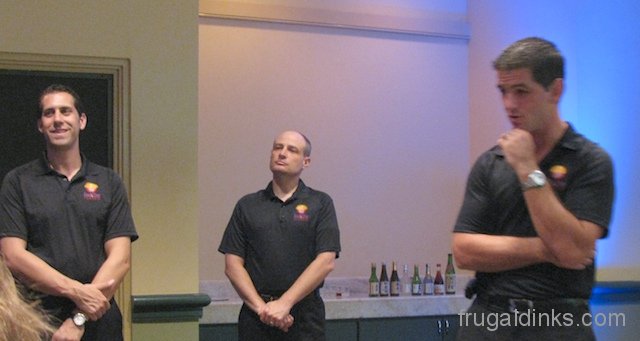
Aaron, Joe, and Chad
Main Presenter: Chad Lobner, General Manager of bluezoo
Chad was the presenter last year, he started with sake when his Food & Beverage manager at Kimono’s challenged him to learn about sake. He started by getting every book he could find about sake that was printed in English. At this point, he was already a first level wine sommelier and as he studied, he became fascinated by how sake is different from wine and beer. In the past year, he became a certified sake specialist. He went to a course run by John Gaunter in Oregon (www.sake-world.com), over 3 days they tasted over 150 sakes (Chad can verify that “if you’re drinking premium sake, you don’t get a hangover.”) In his current position at bluezoo, he likes to experiment and play with sake and how it pairs with the food. On Saturday night, he changed the presentation a bit to accommodate the repeat students (not just us).
Presenter: Joe, Meetings at Swan & Dolphin
Joe lived in Japan for a couple of years and part of his mission while there was to try all things sake. He enjoys sake on a weekly basis at home and often orders it when going out to dinner. Joe really enjoys sake, however he stresses that a good sake is a matter of taste and there are a lot of greys with both sake and Japanese culture. To him, sake is very emblematic of Japan. Interestingly, the grocery stores in Japan are very small, the sake selection takes up about half of a store.
Presenter: Aaron, Sales at Swan & Dolphin
Last year, he walked in to the presentation to help out and discovered that he loves sake and is fascinated by the culture and history attached to sake. He’s learned a lot in the last year, before that, he didn’t know much of anything about sake. He loves the crisp, clean taste of sake.
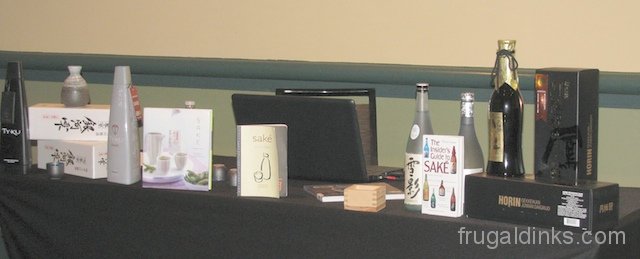
Introduction from Chad:
Disclaimer: Sake is not black and white like wine is, not in terminology, not in classification, not in standardization of practices and labeling. These greys led him to be intrigued by sake. Not all sake is hot, and typically hot sake is not good or premium sake.
Earlier this year, Japan suffered from an earthquake and a tsunami – and a catastrophic failure at a nuclear plant, these events impacted the the sake market; but did not impact the quality and safety of sake. The Japanese are not overly concerned about radiation after last spring, but they’ve been very careful with testing sakes to make sure they’re safe. The sake that’s coming on the market now was already well into the brewing process when the earthquake and devastation occurred. Even so, it’s a uphill battle for sake producers – one to produce sake, two to make it available for export, and three to find export outlets. Add to this, a lot of the sake that we see in the U.S. is the cheaper, lesser quality products. Globally, sake production and consumption has been declining.
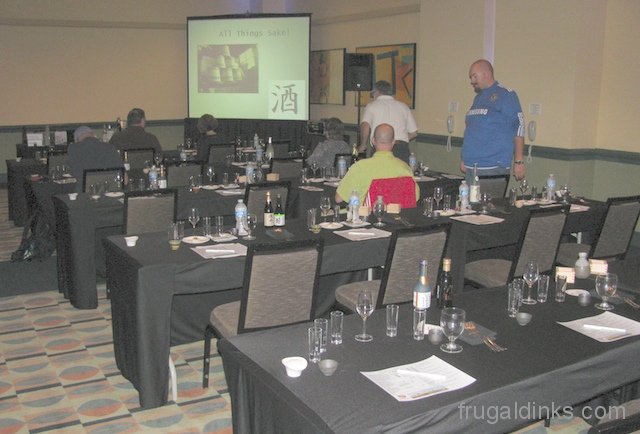
Our "classroom"
What is sake?
Sake is very different from beer and wine in the creation process, it is more akin to a spirit in terms of the brewing method. Sake brewing all happens simultaneously in one tank; wine and beer brewing processes have more distinct separate stages and vessels. The natural alcohol content of sake is about 20%, but water is typically added at the bottling stage to bring that to 15-16%.
Sake, or what we think of as sake, is know as “o-sake-o” an honorific that helps denote the status of sake in Japanese culture. The term “sake” actually refers to all alcoholic beverages in Japanese. Sake is part of daily life in Japan, you can find it nearly everywhere, including in vending machines at the parks. Nearly every town has its own sake brewery.
Sake, as known today, is believed to be nearly 1000 years old. Premium Ginjo is approximately 40 years old. Shortly after WWII, Japan allowed the kuras to add alcohol to their sakes because of rice shortages. In the 1960’s the Japanese tax department forbid the use of adulterants and sake must have less than five ingredients, Junmai (meaning pure) sake has only three ingredients (rice, water, and koji yeast mold). Some brewers add brewers alcohol to fragrance and body – but not to junmai.
Most Americans are familiar with futsu-shu sake. This is the sake that you usually get warm at sushi bars, this is not premium sake. In Japan, it’s “table sake”. Some futsu-shu sakes are quite good, but access to them here in the U.S. is very limited. Joe recommended that we try “chicobai” futsu-shu, this is a table sake readily available at Publix and is of junmai quality.
How is sake made?
Brown rice is milled, washed, and soaked in water. After the rice has absorbed some water, it is steam-cooked. After cooking, the rice is mixed with yeast and koji (a mold grown on rice). The whole mixture is allowed to ferment in a koji room for 3 to 4 days; additional rice, koji, and water are added during this process. Koji rooms are typically all cedar, and the rice is spread out to allow the koji to propagate on the rice itself. Sake rice contains starch which is converted into glucose, the koji eats the glucose and create alcohol. There are different strains of koji, but they’re not cultivated to produce significantly different flavors in the sake.
The actual fermentation takes place in a large tank, and the resulting mixture is called mash. The mash is allowed to sit from 18 to 32 days, after which it is pressed.
The “kuributo,” sake maker, determines his sake’s classification. Although there are official guidelines for sake classification, the final determination is up to the sake brewer. He (or she, there are a few female kuribotos), decides if the sake is junmai, honjozo, junmai ginjo, ginjo, junmai daiginjo, or daiginjo (excellent chart and explanation here).
This year, there were two small dishes of rice for us to look at and touch. One dish contained rice that was milled to 50% of it’s original size, it looked pearlescent. Why is the rice milled? Milling removes the acids and fatty acids found in the outer layers of rice, this removes the congeners (thought to contribute to hangovers). So, can you avoid a hangover by drinking sake? Only if you drink the premium stuff. Chad went online to get the demos (the rice and such) – homebrewedsake.com – so far, he hasn’t experimented with making his own sake, maybe next year?
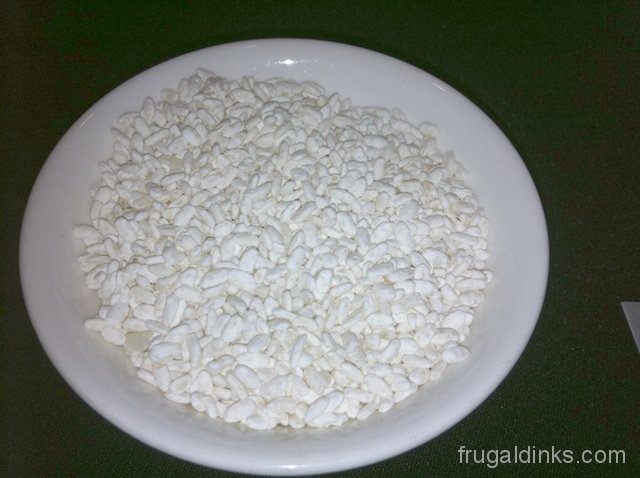
Rice with koji propagated on it
When should you drink sake?
Anytime is a good time for sake! No, seriously…
Sake is brewed over the winter months, so you start to see “new” sakes here in the U.S. in the autumn. In general, you want to drink young sakes.
How will you know the age of your sake? Check the bottle date, keeping in mind that this isn’t always easy to interpret. Chad suggests that you buy and drink within 12 months of the bottle date, 18 months on the outside. Aged sakes do exist, but Chad and Joe both say “stay away.” If you order sake in a restaurant and it appears that the sake was iced down to chill, you probably want to reject it. The highest quality sake “needs” to be kept cold from when it is bottled until when it is served. This makes the highest quality sakes very expensive. If the bottle is dusty or looks like it’s been on the shelf for a while, you probably want to reject it.
Temperature of your sake
Premium sakes are typically drunk chilled. However, if you’d like, try your sakes at varying temperatures (this doesn’t mean hot or really warm). As the sake slightly warms on the table, observe how the flavors and scents change with the temperature.
Some quick vocabulary
- The large sake vessel, the little vase, is called a “tokuri” and the small sake cup is called an “ochoko”.
- Sometimes sake will be served with the ochoko in a cedar box. The cedar box is actually a unit of measure in Japan, it is one-go and sake is bottled in bottles of two-go and 4-go. In other words, sake is bottled as two-servings and four-servings.
- The traditional sake toast “kampai” means “empty glass.”
- Although not really a sake (because it isn’t made of rice); “soju” or “shoju” is brewed like sake using starches other than rice (example sweet potatoes). It tends to pick up flavors of the starches and is often 48-50 proof, soju tends to be an acquired taste.
Food Accompaniments with our sake tastings
- Tuna Tartare – a simple presentation of sushi tuna with soy, sesame, ginger, candied ginger, a little shirachi sauce and roe
- Shrimp Salad – poached shrimp, condensed milk, pineapple, ginger, toasted walnuts, a small taste of shirachi sauce

Tuna Tartare
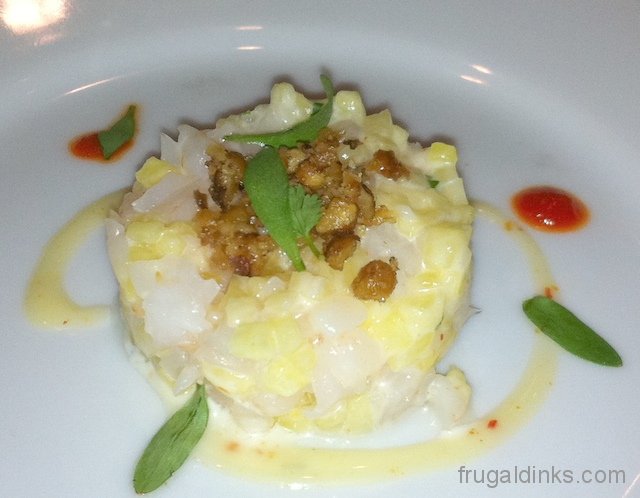
Shrimp Salad
Tastings
the first 4 are “fast starter” sake (one is hidden by the water glass)
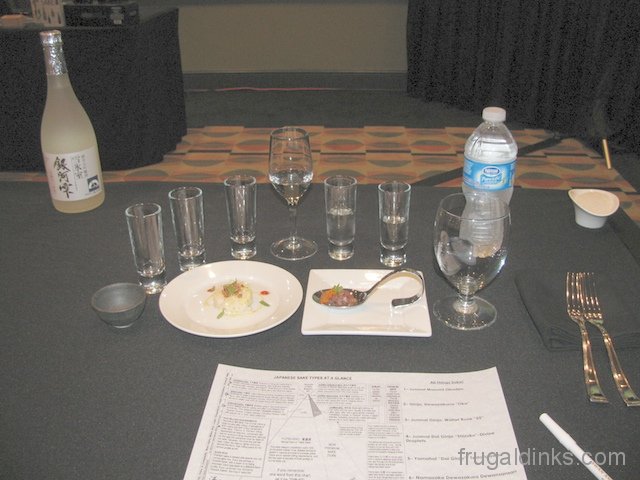
Tastings were right to left
1 – Junmai Masumi Okuden
Joe says that this sake is easy to find locally and that it is “pure, less flavored sake.” This is one of the first sakes that Chad had. It’s made of rice, koji, yeast and water.
nora: nose is very springtime, smells like fruit tree blossoms; very clean, very smooth; some acidity; very light; evaporates quickly in the mouth
nick: smooth, clean — almost flavorless, no aftertaste, almost disappears on the tongue; even though this isn’t of highest quality, I really like the flavor; can’t tease out any distinct flavors, but I like this a lot
2 – Ginjo, Dewazakurra “Oka”
“Oka” means cherry blossom and this sake comes from the largest brewery in Japan. This is Aaron’s favorite and Chad’s second favorite of the “fast starter” group. The retail price point for Dewazakurra is around $15 for 300 mL. The rice is milled to 70%, may have a little brewers alcohol added to enhance aromas and flavors. This sake is a higher grade than the first sake and contains a little more residual sugar. We tasted the tuna tartare with this sake, and it was very tasty!
nora: fruit, melon, banana, anise, less flavor than the first sake
nick: should smell sake like a spirit (not like a wine), cantaloupe, slight anise scent, more flavor, more alcohol flavor, slight aftertaste = not bad, but not good — second night, I taste slight cherry and anise, no banana; perhaps sweeter than #1; this isn’t a flavor that “wows” my tongue; I prefer #1
3 – Junmai Ginjo, Watari Bune “55”
Junmai means “pure” and it contains only four ingredients (no added brewers alcohol), the rice is milled to 55% of original size (thus the name “55”). This sake is particularly appropriate for the rice that it’s made from. Joe likes this sake and would love to have it offered at Kimonos with Japanese pickles (yea! add pickles to the menu please). This is a fairly simple sake with a more muted nose yet fully flavored.
nora: very light, goes very well with the tuna; really like the flavor of this one
nick: aroma = cannot identify, but I like the smell, much more muted, aroma isn’t as full as the previous sake; I think maybe hints of canteloupe; no alcohol added; flavor = more flavor yet, but less alcohol than #2 (flavor); almost sweet, maybe too sweet; heavier taste not as immediately pleasant; complemented the tuna very well
4 – Junmai Dai Ginjo “Shizuku” – Divine Droplets
“Shizuku” is a drip press method of making sake, as opposed to an accordian press and a weighted press. Actually, calling it a drip “press” is a bit of a misnomer… this brewer constructs an igloo and hangs the burlap sake mash bags inside and lets it drip in the cold environment. This sake is made from four ingredients, from rice 50% milled. It has a higher price point of $120-150 per bottle at restaurants or $75 for small bottle. This is Chad’s favorite, he says its the “cadillac of sake”. “Dai” means “big” – as in big flavors, big smells, and big sake. It is served in a cordial glass for our class to help to concentrate the aromatics. Although there are traditional sake vessels, you’re not bound to using any particular serving glass/cup/box – use what works best with a particular sake.
nora: this sake makes nice “legs” in the glass, definitely more like a spirit than a wine; very good; very smooth; disappears almost immediately on the palate; pairs excellently with the tuna tartare; my favorite
nick: aroma is heavier; maybe nutty??; possibly more anise; aroma is not as good to my nose; why is this chad’s favorite?; too much aftertaste; I ate all of the tuna tartare because Chad said it goes well with this sake, I think this sake really needs food?!
nick on 2nd night: aroma is lighter than #2 or #3, but nothing really pops! another taste… WOW! very drinkable without food! clean, crisp finish; the tuna tartare actually mutes the clean taste; more enjoyable as a “sipping” sake
5- Yamahai “Dai Ginjo” – Tedorigawa
This is Aaron’s favorite, “yamahai” is an old classic style sake. Yamahai does not have added lactic acid.
nora: love it; zestier with a strong nose, very clean, light floaty scents; flavors are richer and fuller; would pair very well with pork
nick: aroma is not as heavy as #4; fresher; bright; possibly green bananas; flavor more to my liking; smoother tastes; would go well with american food; I can’t identify why I like it; there isn’t any aroma or flavor component that really jumps out in front; I like it
6 – Namazake Dewazakura Dewansansan
“Namazake” means unpasteurized thus this sake must remain chilled; when exported it must be refrigerated all the way from Japan. “Dewazakura Dewansansan” is the name of this sake and it means “primal strength.” Chad says that this one has nutty aromas
nora: more robust, sweeter; nose is very light, I detect very ripe fruit like bananas and melon; non-pasteurized thus there is more acidity; to me the nose is like my autumn cookies; palate is very spicy and up front; excellent
nick: smells like a half ripe banana, good; almost tastes like a half ripe banana with pineapple; clean nose but slightly heavy tones too… nuts; might pair well with food in general; the shrimp salad was good with this sake; hmmm, I see this paired with some of nora’s fabulous cookies or possibly included in a new cookie creation
7 – Junmai Nigori, Hikos “Milky”
Nigori must remain chilled although it is a filtered sake it contains rice solids. This particular nigori is not as thick as some; there are nigoris that have the consistency of milkshakes. Chad says that while these are good, they’re definitely an acquired taste because of the consistency.
nora: ok, not my favorite; very smooth; very sweet; the rice solids created a very thin film on top of the sake as it sat
nick: fresh scent compared to #6 and #8; creamy when compared to any of the other sakes; cannot identify anything distinct in the flavor; not bad but not tops on my list; on second tasting, little or no nose, flavor is sweeter but not heavy, still not a favorite
8 – Hisui Red Sake
The yeast makes this sake red, not red rice. Nick enjoyed this very much last year, Nora not so much.
nora: needs rich food; smells of sherry and raisins, not a favorite aroma or flavor profile for me; should be paired with a really rich dessert like a creamy pudding or chocolate or a cheese course
nick: smells of raisins; flavor is very good; I really like this sake; would pair well with a sweet dish/dessert; Chad suggests creme brûlée as a food to have with this; on second night, still taste raisins, definitely should pair with a dessert, on discussion we’re thinking fruitcake as a pairing; possibly my favorite
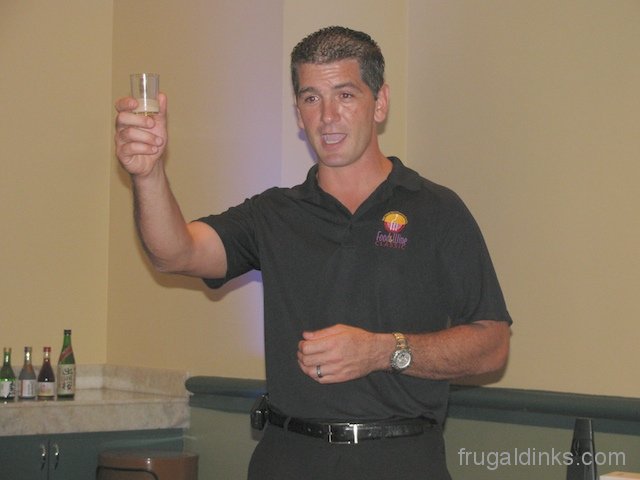
Kampai!
Some final/additional thoughts from nick:
Last year (the first for the Swan and Dolphin Food & Wine Classic) these classes were part of a $50 all-you-care-to-partake-of-on-the-causeway “package”. They all sold out very quickly. Our class was packed last year even though it was possible to just register and get your wristband and leave. This year there were only eight students in our Friday class. The price for the class only (no causeway food) was $35. Now when you value the 8 sakes we tasted – this was a true bargain. I’d say at retail we tasted at least $100 worth of sake pours. Plus because the class was not full, Joe passed out the extra food that Kimonos had made (just in case they had “walk-ups” register)!
We did this class twice again this year because we are not wine drinkers. The only other options (besides the wine classes) were a mixology class (where they do a lot of cocktails with liquid nitrogen) and a beer class. Neither of these seemed appealing so we stuck with the sake. I’m glad we did because I did learn more. With all the Japanese words and the delicate flavors I found myself struggling to keep up last year. I think I enjoyed this year more because I had some knowledge walking in.
We were told that the staff were disappointed with the seminar registrations being so low. They are already planning to tweak the pricing for next year to try to increase demand. Plus they expect to dramatically expand the booths on the causeway (it probably doubled this year!). They may also offer a VIP area as well. There was one set-up this year for sales and for “press”. You could not “buy” a ticket in.
Kate and Calvin did the Riesling seminar last year and this year. They were of similar opinion – last year at $50 this was an incredible bargain. The seminar *may* be worth $35. But Kate said she will be interested to see what price changes they make for next year.
I think Nora and I need to do a more general wrap up post about the 2nd annual Swan and Dolphin Food & Wine Classic. There is much that can be said, especially if you compare and contrast it with what is happening to Epcot’s Food and Wine event…